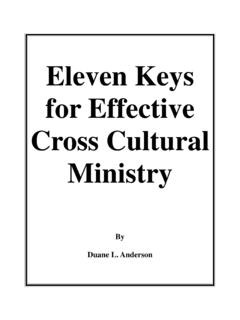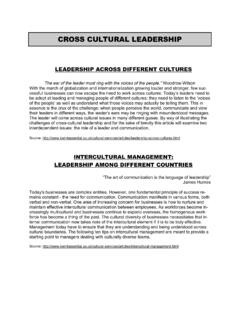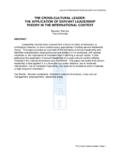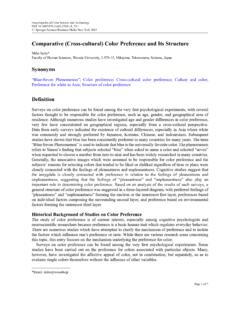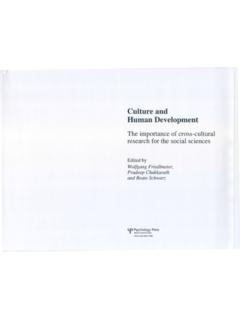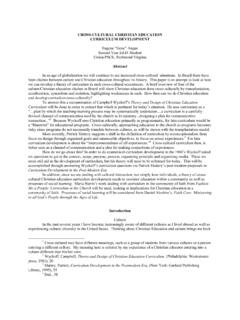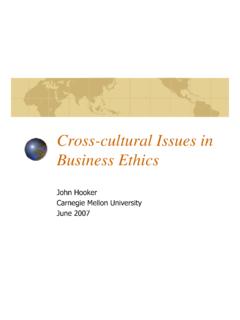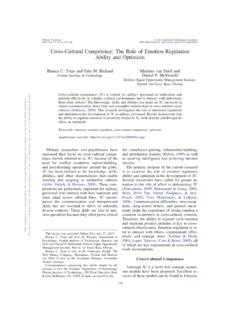Transcription of Guidelines for Best Practice in Cross-Cultural Surveys
1 FOURTH EDITION Guidelines for best Practice in Cross-Cultural Surveys FULL Guidelines Copyright 2016 by the survey Research Center, Institute for Social Research, University of Michigan. All rights reserved. Guidelines for best Practice in Cross-Cultural Surveys ISBN 978-0-9828418-2-2 (PDF) Library of Congress Control Number: 2010937486 2011 Cross-Cultural survey Guidelines Copyright 2016 Do not distribute or reprint without permission i Revised August 2016 Table of Contents Study Design and Organizational Structure.
2 1 Study Management .. 34 Tenders, Bids, and Contracts .. 74 Sample 99 Questionnaire Design .. 150 Instrument Technical Design .. 181 Translation: Overview .. 233 Translation: Management and Budgeting .. 286 Translation: Team .. 297 Translation: Scheduling .. 310 Translation: Shared Language Harmonization .. 321 Translation: Assessment .. 341 Translation: Tools .. 354 Adaptation .. 378 Pretesting .. 392 Interviewer Recruitment, Selection, and Training .. 419 Data Collection: General Considerations .. 469 Data Collection: Face-to-Face Surveys .. 512 Data Collection: Telephone Surveys .
3 542 Data Collection: Self-Administered Surveys .. 550 Paradata and Other Auxiliary Data .. 576 Data Harmonization .. 617 Data Processing and Statistical Adjustment .. 636 Cross-Cultural survey Guidelines Copyright 2016 Do not distribute or reprint without permission ii Revised August 2016 Data Dissemination .. 688 Statistical Analysis .. 714 survey 748 Ethical Considerations .. 794 Cross-Cultural survey Guidelines Copyright 2016 Do not distribute or reprint without permission Introduction iii Revised August 2016 Introduction The number and scope of Surveys covering many cultures, languages, nations, or regions have increased significantly over the past decade.
4 This has led to a growing need to provide information on best practices across the multiple phases of multinational, multicultural, or multiregional ( 3MC ) survey design and administration to ensure the collection of high quality comparative data. However, there is very little published information on the details of implementing Surveys that is specifically designed for comparative research. For example, little has been published on what aspects of 3MC Surveys need to be standardized and when local adaptation is appropriate. The aim of the Comparative survey Design and Implementation (CSDI) Guidelines Initiative was to develop and promote internationally recognized Guidelines that highlight best Practice for the conduct of comparative survey research across cultures and countries.
5 The intended audience is researchers and survey practitioners planning or engaged in 3MC research. However, we believe that the Guidelines also could benefit researchers and survey practitioners involved in single country Surveys . The goal of the CSDI Initiative has been to develop Cross-Cultural survey Guidelines (CCSG) as presented here, which cover all aspects of the survey lifecycle. This currently has resulted 18 chapters and 11 sub-chapters. Three additional chapters on study design and organizational structure, survey quality, and ethical considerations are relevant to all processes throughout the survey production lifecycle.
6 survey quality can be assessed in terms of fitness for intended use, total survey error, and survey production process quality monitoring. This may be affected by survey infrastructure, costs, interviewer and respondent burden, as well as study design specifications. Figure 1 presents a diagram of the survey lifecycle. The 18 chapters and 11 sub-chapters of the CCSG Guidelines are: Study Design and Organizational Structure Study Management Tenders, Bids, & Contracts Sample Design Questionnaire Design Instrument Technical Design Translation Overview Managing and Budgeting Team Scheduling Shared Language Harmonization Assessment Tools Adaptation Cross-Cultural survey Guidelines Copyright 2016 Do not distribute or reprint without permission Introduction iv Revised August 2016 Pretesting Interviewer Recruitment, Selection.
7 And Training Data Collection General Consideration Face-to-Face Surveys Telephone Surveys Self-Administered Surveys Paradata and Other Auxiliary Data Data Harmonization Data Processing & Statistical Adjustment Data Dissemination Statistical Analysis survey Quality Ethical Considerations Figure 1. The survey Lifecycle Cross-Cultural survey Guidelines Copyright 2016 Do not distribute or reprint without permission Introduction v Revised August 2016 The CCSG Guidelines draw upon and are based on: (1) general good Practice survey methodology, as well as Cross-Cultural and comparative literature on survey methodology; (2) available study-specific manuals and documentation; and (3) the experiences and lessons learned that authors, reviewers, and editors have added through their work on and with numerous comparative Surveys .
8 best practices are dynamic and can be expected to evolve over time. At the present time, the Guidelines relate to not just cross -sectional Surveys of households and individuals but also computer-assisted personal interviewing modes and the usage of paradata and statistical analyses. At a later point in time, they may be expanded to include establishment and longitudinal Surveys . As more documentation and information about comparative Surveys become available, we hope to incorporate the lessons learned from these studies into the CCSG Guidelines . New methodological research will also inform new versions of the CCSG Guidelines .
9 You can greatly help us in these objectives by providing comments and suggestions, or simply alerting us about a topic we need to address. Please contact us at: Citations: Please cite these Guidelines as follows: survey Research Center. (2016). Guidelines for best Practice in Cross-Cultural Surveys . Ann Arbor, MI: survey Research Center, Institute for Social Research, University of Michigan. Retrieved Month, dd, yyyy, from The CCSG initiative is led by Beth-Ellen Pennell, currently the director of international survey operations at the survey Research Center, Institute for Social Research at the University of Michigan.
10 Also instrumental in the development and operationalization of the Guidelines are Kirsten Alcser and Sue Ellen Hansen of survey Operations, survey Research Center, Institute for Social Research. The Guidelines were initiated at the 2005 meeting of CSDI and have involved more than 70 individuals from more than 35 organizations worldwide. We dedicate these Guidelines to Dr. Janet A. Harkness. Dr. Harkness passed away in 2012. She initiated the International Workshop on Comparative survey Design and Implementation where the development of these Guidelines was launched. Dr. Harkness not only contributed to the overall framework and content of the Guidelines but she also authored three of the original key chapters: Questionnaire Design, Adaptation and Translation.
